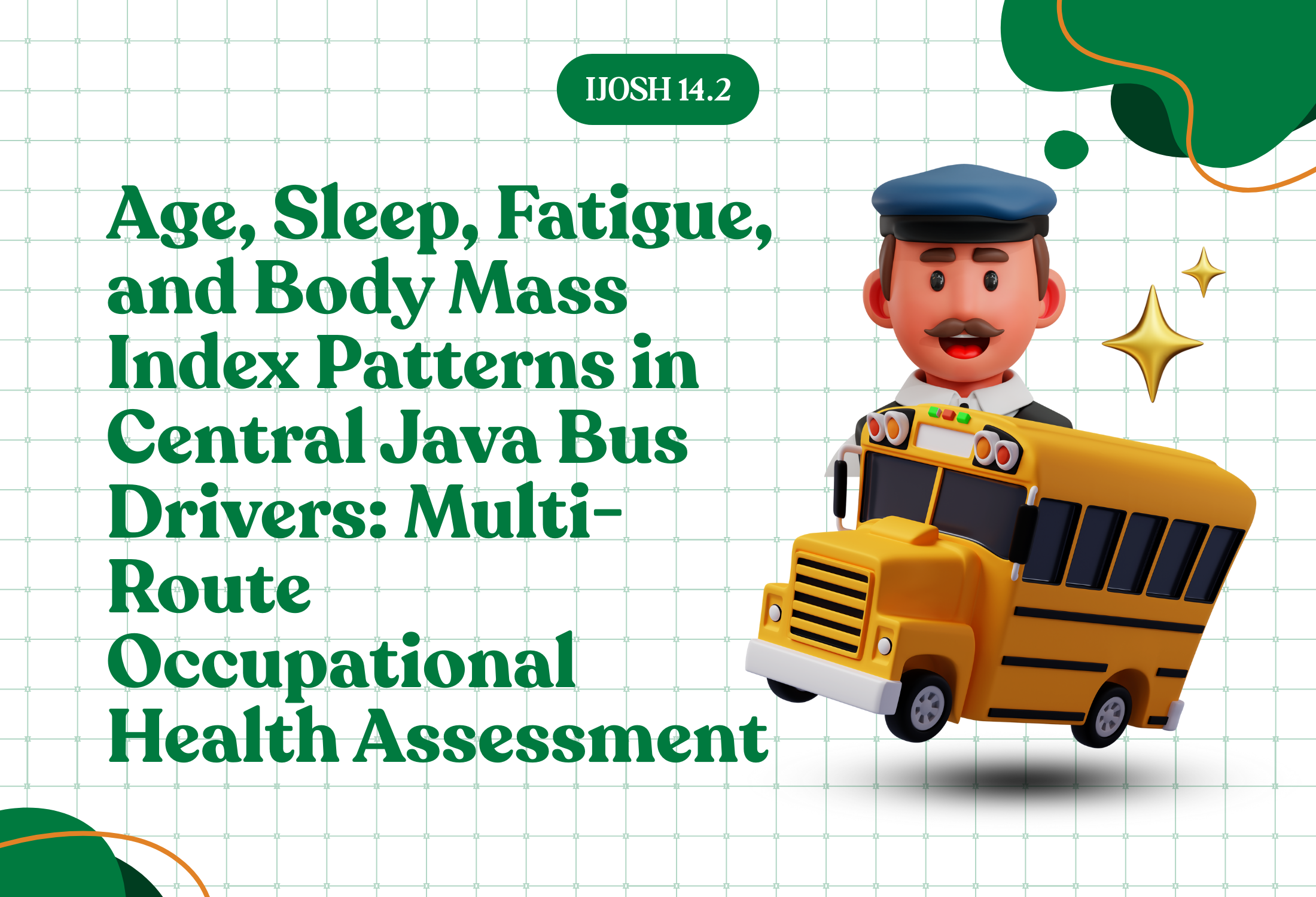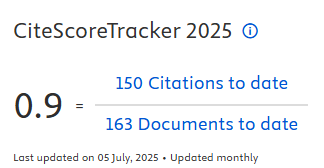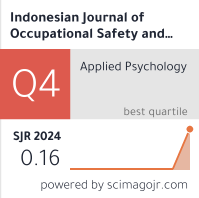Age, Sleep, Fatigue, and Body Mass Index Patterns in Central Java Bus Drivers: Multi-Route Occupational Health Assessment

Downloads
Introduction: Indonesia's growing transportation demands have increased reliance on bus services across Central Java Province. Despite their importance, driver health remains understudied, even as driver factors account for 65% of public transportation accidents. This study investigates differences in health characteristics among bus drivers across three distinct routes: Trans Jateng, BRT Semarang City, and Inter-City Bus Transportation Services Between Semarang-Surakarta. Methods: This quantitative cross-sectional study conducted in Semarang City and Surakarta City examined 210 bus drivers between January 2023-August 2024 using interviews, questionnaires and stature meters. Variables included age, sleep duration, fatigue levels (using the Industrial Fatigue Research Committee questionnaire), and Body Mass Index. Analysis employed Kruskal-Wallis tests followed by Mann-Whitney post-hoc tests with Bonferroni correction. Results: Analysis revealed significant differences across all variables (p<0.001). Trans Jateng drivers (mean age 43.1 years) demonstrated optimal sleep (7.0 hours), low fatigue levels (88.6%), and healthier BMI profiles (74.3% normal). BRT Semarang City drivers (mean age 44.2 years) showed paradoxical characteristics with longest sleep duration (9.5 hours) yet highest fatigue levels (80% very high) and poor BMI profiles (84.3% overweight/obese). Inter-City drivers, despite being older (mean age 51.4 years) with shortest sleep duration (5.4 hours), showed moderate fatigue adaptation (92.9%) and similar BMI concerns (84.2% overweight/obese). Conclusion: Significant differences (p<0.001) exist among three public transport driver groups. Trans Jateng showed the best health profile, BRT Semarang City paradoxical with long sleep yet high fatigue, and Inter-City adaptive despite insufficient sleep. Sleep duration does not correlate with fatigue levels. Group-specific health interventions are needed.
Amoadu, M. (2023) ‘Psychosocial factors, Perceived Well-Being, and Safety Incidents among Long-Distance Commercial Drivers in Ghaha’. Dissertation. Ghana: Faculty of Science and Technology Education, College of Education Studies, University of Cape Coast.
Bharadwaj, N., Edara, P. and Sun, C. (2021) ‘Sleep Disorders and Risk of Traffic Crashes: A Naturalistic Driving Study Analysis’, Safety Science, 140, p. 105295.
BPS Provinsi Tengah Jawa (2025) Badan Pusat Statistik Provinsi Jawa Tengah. Available at: https://jateng.bps.go.id/id (Accessed: 18 March 2025).
Bramantyo, M. F. and Nugroho, S. W. (2023) ‘Analisis Faktor-Faktor Penyebab Kelelahan Kerja dengan Metode Subjective Self Rating Test (Studi Kasus: Pekerja Bagian Lantai Produksi PT. Marabunta Berkarya Ceperindo)’, Industrial Engineering Online Journal, 12(1), pp. 1-10.
Chen, H. K. et al. (2019) ‘Structural Interrelationships of Safety Climate, Stress, Inattention and Aberrant Driving Behavior for Bus Drivers in Taiwan’, Transportation Research Part A: Policy and Practice, 130, pp. 118–133. doi: 10.1016/j.tra.2019.09.007.
Chen, J.-J. et al. (2024) ‘Exposure and Health Risk Assessment of Volatile Organic Compounds among Drivers and Passengers in Long-distance Buses’, Environmental Research, 252, p. 118959.
Chen, M.-S., Chiu, C.-H. and Chen, S.-H. (2021) ‘Risk Assessment of Metabolic Syndrome Prevalence Involving Sedentary Occupations and Socioeconomic Status’, British Medical Journal Publishing Group, 11(12), p. e042802.
Daiyah, C. F. (2022) ‘Beberapa Faktor Penyebab Kecelakaan di Indonesia’, Jurnal Ilmu Teknik, 2(2), pp. 1-9.
Dishub (2025) Dinas Perhubungan Provinsi Jawa Tengah. Available at: https://perhubungan.jatengprov.go.id/ (Accessed: 18 March 2025).
Dwitama, M. K. et al. (2024) ‘Analisis Kesesuaian Transportasi Bus Rapid Transit (BRT) di Kota Tasikmalaya: Belajar dari Model Transjakarta’, Jurnal Ekonomi dan Bisnis, 2(5), pp. 569–578.
Hajducik, A. et al. (2021) ‘A Study of the Behavior and Responsibility of Slovak Drivers, Especially in Case of Fatigue’, Applied Sciences, 11(17), p. 8249.
Henky, G. (2021) ‘Analisis Faktor Human Error, Kondisi Jalan Dan Kondisi Kendaraan Yang Mempengaruhi Kecelakaan Lalu Lintas (Studi Kasus Pengguna Sepeda Motor Di Jalan Pantura Kaliwungu Kendal)’. Undergraduate Thesis. Semarang: Universitas Maritim AMNI.
Ihsan, T. et al. (2020) ‘Fatigue Analysis to Evaluate Workloads in Production area at Crumb Rubber Factories of Padang city, West Sumatra Indonesia’, Indian Journal of Occupational and Environmental Medicine, 24(3), pp. 148–152.
Jacquay, E. (2024) Impact of Short-Distance Road Transportation on Horse Health. Dissertation. Kentucky: Department of Veterinary Science, College of Agriculture, Food and Environment University of Kentucky.
Lees, T. et al. (2023) ‘Psychophysiology of Monotonous Driving, Fatigue and Sleepiness in Train and non-professional Drivers: Driver Safety Implications’, Behavioral Sciences, 13(10), p. 788.
Liew, C. H. and Flaherty, G. T. (2020) ‘Experiences and Attitudes of International Travelers with Cardiovascular Disease: A Qualitative Analysis’, The American Journal of Tropical Medicine and Hygiene, 102(3), p. 689.
Mabry, J. E. et al. (2022) ‘Unravelling the Complexity of Irregular Shiftwork, Fatigue and Sleep Health for Commercial Drivers and the Associated Implications for Roadway Safety’, International Journal of Environmental Research and Public Health, 19(22), p. 14780.
Maghsoudipour, M. et al. (2022) ‘Time of Day, Time of Sleep, and Time on Task Effects on Sleepiness and Cognitive Performance of Bus Drivers’, Sleep Breathing Physiology and Disorders, 26(4), pp. 1759–1769.
Nurdjanah, N. and Puspitasari, R. (2017) ‘Faktor yang Berpengaruh terhadap Konsentrasi Pengemudi’, Warta Penelitian Perhubungan, 29(1), pp. 141–157.
Roche, J. et al. (2021) ‘Relationship between Sleep Disorders, HIV Status and Cardiovascular Risk: Cross-sectional Study of Long-haul Truck Drivers from Southern Africa’, Occupational and Environmental Medicine, 78(6), pp. 393–399.
Scarpelli, S. et al. (2021) ‘Age-related Effect of Sleepiness on Driving Performance: A Systematic-Review’, Brain Sciences, 11(8), p. 1090.
Shell, A. L. et al. (2022) ‘Associations of Somatic Depressive Symptoms with Body Mass Index, Systemic Inflammation, and Insulin Resistance in Primary Care Patients with Depression’, Journal of Behavioral Medicine, 45(6), pp. 882–893.
Sherry, A. P. et al. (2022) ‘Sleep Duration and Sleep Efficiency in UK Long-distance Heavy Goods Vehicle Drivers’, Occupational and Environmental Medicine, 79(2), pp. 109–115.
Shirath, M. I. H. et al. (2025) ‘Bias Kognitif pada Pengendara Ugal-ugalan di Jalan Pantura Bagian Banyuwangi’, Psycho Aksara: Jurnal Psikologi, 3(1), pp. 1–15.
de Souza, O. F. et al. (2025) ‘Sleep Duration and Energy Expenditure at Work in Motorcycle Taxi Drivers from Rio Branco City, Western Brazilian Amazon: A Cross-Sectional Study’, Indian Journal of Occupational and Environmental Medicine. Medknow, pp. 10–4103.
Syahliantina, A. (2025) ‘Kajian Faktor-Faktor yang Mempengaruhi Terjadinya Kecelakaan sebagai Dasar Mitigasi Kecelakaan Bus Antarkota Antarprovinsi (AKAP)’. Thesis. Surakarta: Faculty of Engineering, Sebelas Maret University.
Tan, M. et al. (2021) ‘Bidirectional Posture-Appearance Interaction Network for Driver Behavior Recognition’, IEEE Transactions on Intelligent Transportation Systems, 23(8), pp. 13242–13254.
Tàpia-Caballero, P. et al. (2022) ‘Age, Gender, Personality, Burnout, Job Characteristics and Job Content as Predictors of Driver Fatigue’, International Journal of Occupational Safety and Ergonomics, 28(4), pp. 2396–2402.
Tavakoli Kashani, A. and Besharati, M. M. (2021) ‘An Investigation of the Relationship between Demographic Variables, Driving Behaviour and Crash Involvement Risk of Bus Drivers: A Case Study from Iran’, International Journal of Occupational Safety and Ergonomics, 27(2), pp. 535–543.
Tsai, C.-Y. et al.. (2023) ‘Aberrant Driving Behavior Prediction for Urban Bus Drivers in Taiwan using Heart Rate Variability and Various Machine Learning Approaches: A Pilot Study’, Transportation Research Record, 2677(3), pp. 1304–1320.
World Health Organization (2018) Global status report on road safety 2015’. Africa: World Health Organization.

This work is licensed under a Creative Commons Attribution-NonCommercial-ShareAlike 4.0 International License.

In order to be accepted and published by The Indonesian Journal of Occupational Safety and Health, Author(s) who submit an article should complete all the review process. The copyright of received articles assigned to the The Indonesian Journal of Occupational Safety and Health and Department of Safety and Health, Universitas Airlangga as publishers of the journal. The intended copyright includes the rights to publish articles in various forms (including reprints).
The Editorial Team of The Indonesian Journal Of Occupational Safety and Health and Department of Safety and Health strive to ensure that no errors occur in the articles that have been published, both data errors and statements in the article.
Users of this website will be licensed to use materials from this website following the Creative Commons Attribution-NonCommercial-ShareAlike 4.0 International License. No fees charged. Please use the materials accordingly.
------------------------------------------------------------------------------------------------------------------------------------------------------------------------------------------
Attribution ” You must give appropriate credit, provide a link to the license, and indicate if changes were made. You may do so in any reasonable manner, but not in any way that suggests the licensor endorses you or your use.
NonCommercial ” You may not use the material for commercial purposes.
ShareAlike ” If you remix, transform, or build upon the material, you must distribute your contributions under the same license as the original.







 How to Submit Articles in OJS
How to Submit Articles in OJS

























